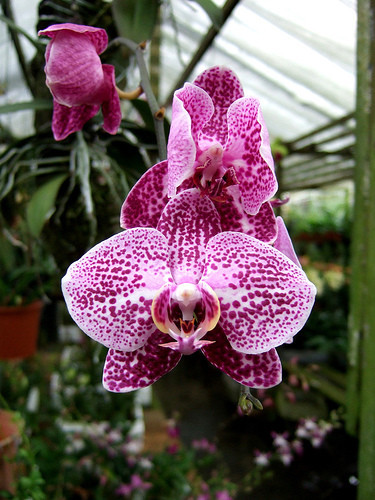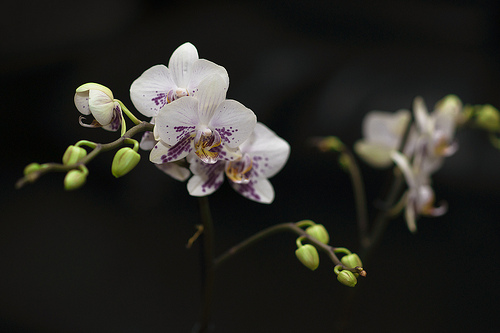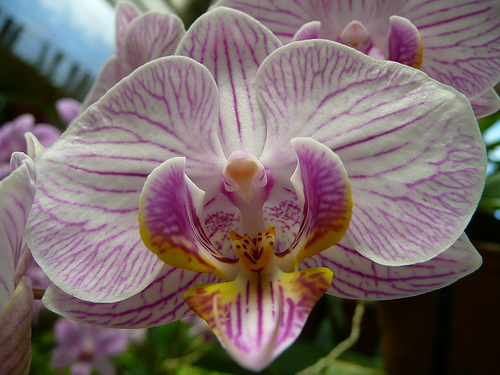Q: I love the elegance and the exotic feel of an orchid, but every time one winds up in my care, I find myself with a dead orchid after a short while. I do well with my other houseplants and like to think I have a green thumb. Are orchids really just that difficult? I was thinking about getting one for someone as a Valentine's present but I don't want it to die -- it would be a bad omen.
A: Orchids are a lovely gift (for so many reasons), but they are not just temporary. Orchids have a few tips and tricks. They are a little bit different from other houseplants, but no more difficult.

Flickr Photo by daveyll
Q: That's sort of a relief. How can I keep the flowers in my home longer?
A: Flowering time on any houseplant is limited, and orchids are no different. While their bloom duration can, and often does, exceed consecutive months, they will eventually go off bloom. Losing the flower does not mean that your plant is dead or diminish the beauty of the plant itself. Check out the form of the leaves, the root structure, rhizomes, pseudo bulbs...
Q: Wait, wait, wait...the what?
A: I got carried away, they're just so mesmerizing...Many orchids are not terrestrial plants, meaning they are not growing in the ground or in a typical potting mix we often use in the home. Check out the roots when you care for your orchid and you will see that they are often potted in a much looser mix -- typically a blend of sphagnum, peat and fir bark (a standard "orchid mix"). While there are different formulas for different types of orchids, an all-purpose orchid mix will get you well on your way to a happy orchid.
Q: If they are planted in special soil doesn't it make them delicate?
A: Don't freak out -- this potting mix readily dries out, meaning these frilly-looking beauties are actually tough as nails. They have developed water-storage means almost like a plant you would find in the desert. Some orchids have thick, knobby roots that will hold on to water (Phalaenopsis orchids or "moth" orchids). Many others feature bulbous growths that support their leaves (Oncidium orchid). The pseudobulbs serve as a water tank for storage. Others still will store water in a rhizome, or a thick root structure that also supports spreading new growth.

Flickr Photo by BarbaraWilli
Q: I guess I'm not an orchid-killer just because the flowers dropped. And now that I know they have all of these 'features' it might be a little easier for me to care for them.
A: These features do indicate how we should care for them and paying attention to them will certainly help. Soaking up the ambient humidity of tropical climates -- the most commonly-gifted orchids need a mock-up of this scenario in the home. While they are accustomed to rains soaking their loose, chunky growing medium, they are also used to this material drying out quickly. Be sure your orchids roots do not stay too wet for too long. The water-storage features we discussed each indicate a slightly different watering technique, but generally a thorough soaking once a week is adequate as long as the material dries in a few days.
Q: It came inserted in a decorative sleeve. So, the water that is sitting at the bottom is a bad thing?
A: Take it out of its sleeve. Ideally your orchid wants a breathable, porous container or one with openings on the side, often called a standard orchid pot. Having the orchid roots be able to breath will expedite the drying time. While the roots appreciate this, the leaves are all but arid. Keep the humidity levels high by misting with water, or setting your plants on a tray of gravel and water, allowing the evaporating water to add humidity to their space. Grouping your plants together will also offer more humidity.

Flickr Photo by gssavage
Q: I'm confident on watering now but what about sun? I always thought that the more sun the more bloom when it comes to plants.
A: Most orchids can only handle mild sunlight. Keeping them in a sunny room, but with no sun rays reaching their leaves is absolutely perfect. While some orchid species can handle more than others, generally ensure that you shield them from direct sun rays in the middle and latter half of the day, as these are the most intense rays.
Q: Wow -- they're pretty much ideal houseplants!
A: Absolutely, and we've only scratched the surface, with tens of thousands of orchids species out there and more to be discovered! Then there are also all of the cultivated hybrids, as well as hybrids between different genera that we call "intergeneric orchids." Many of the terrestrial orchids are ideal houseplants because they are a little more typical and appreciate consistent soil moisture. And an orchid plant might actually be the ideal Valentines day plant to give if you want something lasting.